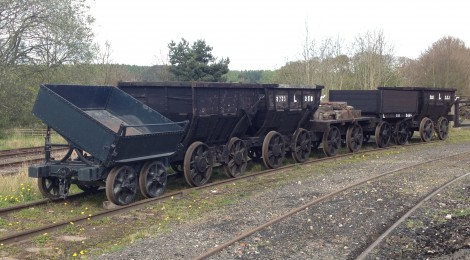
General T&I News Update…
The post-event glow has now faded almost to the point of evaporation as we set about getting ready for the high-season, with numerous things that we didn’t quite finish before Easter being attended to, plus a new round of repairs of the ones that have broken since! Here is a quick review of the T&I activities, on top of which the guys were heavily involved in readying the new refreshment outlet in the Colliery for opening on Good Friday as well as preparing the ground for the start of construction of our new Chemist/Photographers.
Rambler
Below: Vince Allen struggled for three days to create the complex curves and angles of the smokebox doorplate/ring – this being the fantastic result! The original (see earlier post and ‘Rolling Restorations’ on this site) was life expired and somewhat moth eaten, so there was no alternative than to go for a new one. Quite an impressive result – this will now be fitted to the new smokebox and fitted with the new chimney base casting, to give Ramble a decent front end for many years to come I hope!
Below: Meanwhile, back at Beamish the new canopy construction has begun with the renovation of the existing ironwork, before Tony and Matt set about building this back to shape and canvasing it.
Blackpool 167
Below: After completing a highly successful operating stint on Easter Monday, 167 has been readied for its onward journey to Blackpool where it will be operating on Heritage days during the 2014 season (see the Blackpool Transport Heritage Tram website for details).
Below: Andy Bailey’s visit to prepare 167 also enabled a detailed discussion regarding 16’s truck, which is the same as that on the NTM’s Leeds 180 (in fact they have had parts interchanged over the years to further confuse things!). We have drawings, that Peter is studying, non of which correspond with what we can see on the truck – was it a Leeds modification or something else. It is an unravelling mystery. Meanwhile, the testing of springs continues, with the jig adapted to take coil springs. Chris made a trammel to measure the hornguides and spring hangers (in relation to each other and also to check the vertical horn cheeks), revealing that one is out of position and might well account for the twisted axlebox visible at that end. More exploration, discussion, research and head scratching will continue, as Peter and Chris look to find a solution to evident problems and also improve the ride quality of the tram.
Vulcan
Vulcan has now moved across to Rowley Station, replacing Salmon, which departed to its new home near Aberdeen on the Royal Deeside Railway on Tuesday afternoon. Some bits and pieces need to be attended to at Rowley but we will be up and running in time for the first May Bank Holiday, complete (I hope!) with a newly painted and lined Vulcan…
In other news…
Below: Our bread van is off on a little holiday to a food festival at Auckland Castle, seen here loaded and ready for delivery there tomorrow.
Below: A group of the Friends volunteers have been building new telephone boxes for the tram stops around site – the existing boxes being rather weary and in some cases life expired. This sort of work is really useful to us as it enables desirable (rather than essential) work to be expedited, and a rewarding project for those involved to be fairly quickly accomplished.
Below: The horse tram has been lifted and placed on stands, enabling the wheelsets and axleboxes to be removed. The wheels, which are chill cast, appear to be in great shape, which is good as you can’t easily repair chilled castings (grinding is possible and I have seen turning carried out, but at risk of shattering the surface as well as tool). When the wheels are cast, metal inserts (the ‘chills’) are placed in the mould to rapidly cool the molten metal that comes in contact with them and so create a very resilient result – in the case of wheels it ensure the rolling contact areas of the wheels (which aren’t tyred) are extremely tough and highly resistant to wear. Chills are also used to control the cooling rates in the casting process, and can be of a type that is incorporated into the final casting (internal) or that are part of the mould (as in this case), an external chill. These wheels, like most horse tram wheels, were made by Millers of Edinburgh.
The Leeds Transport Historical Society have cast new wheels for their restored horse tram, Leeds 107, and a photo gallery of this fascinating process can be found here: http://leedshorsecar107.squarespace.com/picture-galleries/making-chilled-iron-wheels/
Below: We close with a scene that rather appeals – a selection of our eclectic dumb buffer stock parked behind the Colliery cottages.






















Great update paul as always. Could I ask what is happening with “Lewin” and does the colliery run steam every weekend in the summer ?